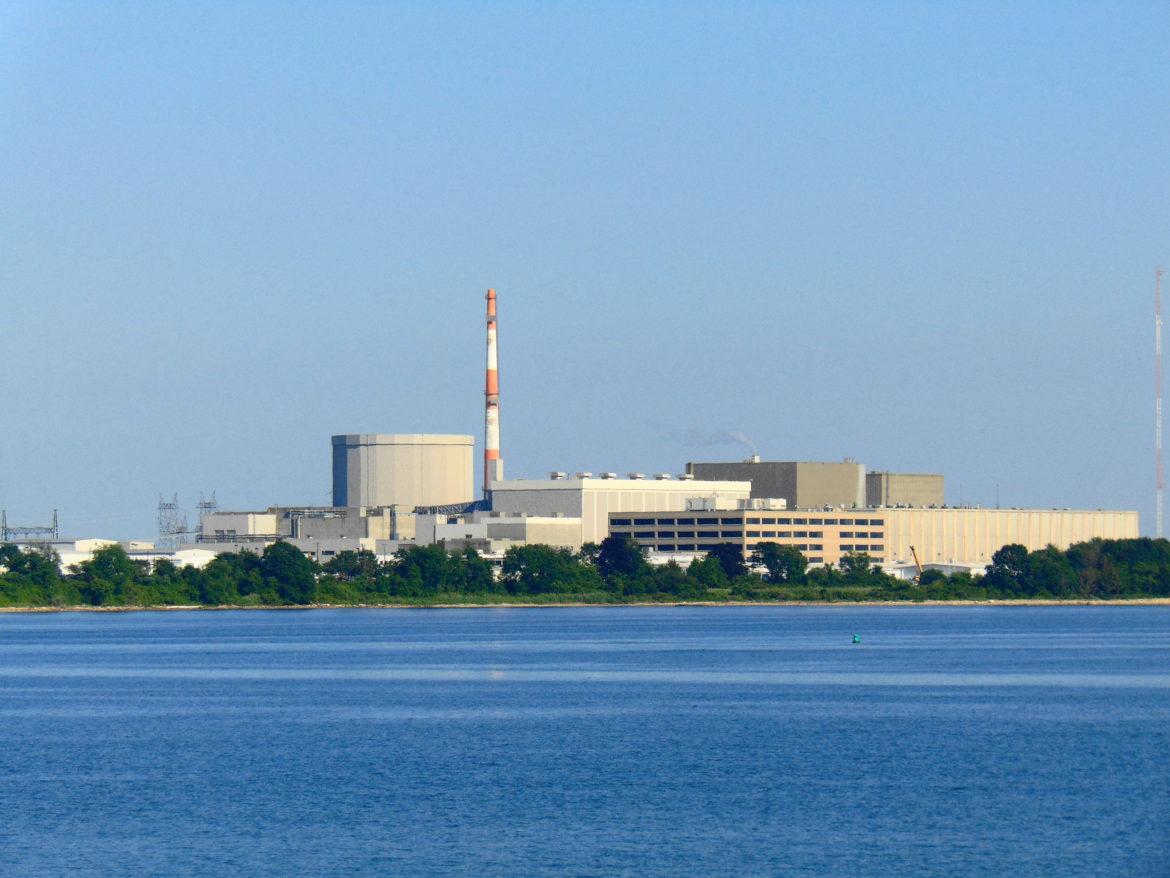
JJBers / Flickr / Creative Commons
Connecticut’s draft integrated resources plan emphasizes that the Millstone nuclear facility, seen here, plays an “outsized role” in pathways to decarbonization.
State energy officials conclude that eliminating emissions in two decades is feasible and affordable, but it will require changes from grid operator ISO New England.
Getting Connecticut to a zero-carbon electric supply is attainable by 2040, but it will require significant regional reforms, according to a new assessment of the state’s future energy needs.
The draft integrated resources plan, prepared by the state Department of Energy and Environmental Protection, says hitting the zero-carbon target set by Gov. Ned Lamont will require reform of the ISO New England wholesale electricity markets, as well as significant upgrades to the power transmission system to better support renewable energy sources.
“But the good news is the target is affordable and feasible to achieve,” said department Commissioner Katie Dykes in an interview.
The Department of Energy and Environmental Protection is statutorily required to prepare the integrated resources plan every two years. This year’s plan marks the first attempt to lay out a blueprint for achieving a 100% zero-carbon electric supply.
The report notes that Connecticut has already made considerable progress toward that goal. Long-term contracts for zero-emission renewables and zero-carbon nuclear resources account for nearly 65% of the power consumed by customers of Eversource and United Illuminating, the state’s two largest utilities.
That percentage is expected to rise to 91% by 2025, as offshore wind and grid-scale solar projects scheduled for construction come online.
In the meantime, Dykes said, “we have to look at turning our wholesale electricity markets into engines of decarbonization, and ensure that our grid is prepared to effectively integrate distributed energy resources and storage and demand efficiency.”
The Lamont administration will be prioritizing work on those reforms over the next few months, she said.
Last October, Lamont joined other New England governors in calling for reform of ISO New England’s regional electricity market design, transmission planning and governance. The market structure has come under criticism for over-procuring capacity, and effectively barring clean energy investments from the capacity market while favoring fossil-fueled generation.
One result of those preferences is that Connecticut has become “a target” for the development of natural gas-fired power plants — aided by the availability of infrastructure — and now hosts a disproportionate share of that and other fossil-fired generation, Dykes said.
Discussions around how to reform the wholesale markets began moving forward this week, with the New England States Committee on Electricity hosting a virtual technical meeting on market design. An ISO New England representative was scheduled to make a presentation.
“We are hopeful that through this process we can find new ways of working together,” Dykes said.
Connecticut’s Public Utilities Regulatory Authority has also been rapidly working through a grid modernization docket, a comprehensive effort aimed at making the grid more resilient, equitable and clean energy-friendly.
The agency recently released straw proposals for establishing the state’s first energy storage program and for the strategic deployment of electric vehicle infrastructure.
The draft integrated resources plan models a range of scenarios for reaching 100% zero-carbon electricity by 2040. It emphasizes that the Millstone nuclear facility plays an “outsized role” in those pathways to decarbonization.
Last year, Connecticut entered into a 10-year contract with Millstone for 9 million megawatt-hours of energy, or about 36% of the utilities’ load, after Millstone’s owner, Dominion Energy, warned of the facility’s potential closure. State agencies concluded that such a closure would threaten the state’s energy security.
Some of the draft plan’s model pathways assume that Millstone will be retired when that contract ends in 2029, which will require significant procurements of new renewable builds.
Other models test the possibility of Millstone’s continued operation through 2040, a scenario that allows the state to hit the zero-carbon goal at a lower cost. That’s because keeping the facility generating would reduce the need for new resources early on to replace the nuclear power. It would also allow more fossil-generated facilities to retire in the interim.
However, the plan says, if Millstone were to continue operating beyond 2029, Connecticut ratepayers should not be the ones to bear the full financial burden again. Rather, the facility “should be supported regionally through a reformed ISO-NE wholesale market, or by some other regional mechanism.”
Another factor that will significantly impact the timing of procurement of new renewable resources is the rate of electrification of the building and transportation sectors.
The report also notes the importance of continuing with the state’s energy efficiency programs in order to help drive down demand, thereby reducing the need for new supply. Those programs, which are funded through a ratepayer surcharge and administered by the utilities, are just getting back up to speed after state lawmakers raided the funds several years ago to help resolve budget problems.
As the state once again faces a difficult economic landscape, due to the pandemic, Dykes said she thinks the funds are safer this time.
“During the pandemic, as we’ve seen households being impacted, people working at home and consuming more electricity — energy efficiency programs have been one of the most impactful solutions that ratepayers have been able to access to lower energy use and costs,” she said. “Awareness of their value, in terms of reducing emissions, creating jobs, and lowering bills, has never been more widely recognized.”The Department of Energy and Environmental Protection is holding virtual public hearings on the draft plan on Thursday, Jan. 14, as well as two technical meetings later in the month. Public comments may be submitted to DEEP.EnergyBureau@ct.gov through Feb. 15.
Original source: Energy News Network